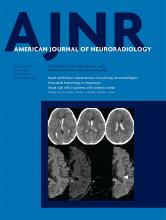This letter is in response to the Practice Vignette “Chimeric Antigen Receptor T-Cell Therapy: What the Neuroradiologist Needs to Know” by Valand et al. The authors reviewed the neuroimaging findings in patients with chimeric antigen receptor T-cell (CAR T) and recommended that MR imaging of the brain be considered before treatment to better distinguish chronic from acute changes.
On the basis of our extensive experience with CAR T neurotoxicity, we would like to provide our perspective on the authors' conclusion that imaging findings in neurotoxicity are nonspecific. We and others have found several characteristic patterns in both children and adults with CD19-CAR T–related neurotoxicity.1⇓⇓–4 The most common pattern includes reversible T2 hyperintensities and swelling in the bilateral thalami, pons, and medulla, often accompanied by symmetric white matter T2 hyperintensities that are subcortical or affect the external and extreme capsule (Fig 1A). Less specific, but still characteristic, are focal white matter T2 hyperintensities with or without contrast enhancement, which may occur at sites of prior CNS injury (Fig 1B). A rare variant is cortical diffusion restriction with subsequent cortical atrophy (Fig 1C). Finally, global cerebral edema is seen in the most severe cases, and the bithalamic swelling can often be appreciated in these patients (Fig 1D).
Characteristic imaging findings in CD19-CAR T–related neurotoxicity. A, FLAIR image showing bithalamic edema and symmetric white matter T2 hyperintensities. B, T1 + gadolinium image of asymmetric enhancing white matter lesions. C, Diffusion-weighted image showing right > left occipital cortical diffusion restriction. D, FLAIR image of a patient with global cerebral edema.
The role of CNS imaging before CAR T treatment is not well-defined at this point. In a pediatric cohort of 43 patients, we found a higher incidence of neurotoxicity in patients who had abnormal MR imaging findings before CAR T infusion, compared with those who had normal findings or no imaging.3 However, this conclusion is tempered by the fact that pretreatment imaging was not available for all patients. We agree with the authors that comprehensive imaging before CAR T treatment would be very helpful in assessing whether any abnormalities during treatment are acute or chronic. This question should be answered via a clinical trial to rigorously evaluate the yield of routine head imaging in patients who undergo CAR T treatment. Imaging can be cumbersome and expensive, especially for pediatric patients who require sedation.
Footnotes
Disclosures: Juliane Gust—RELATED: Grant: National Institute of Neurological Disorders and Stroke, Comments: Child Neurology Career Development Program K-12 award (1K12NS098482-02).* *Money paid to institution.
Indicates open access to non-subscribers at www.ajnr.org
- © 2019 by American Journal of Neuroradiology








